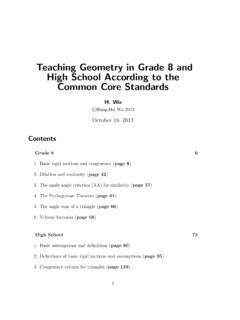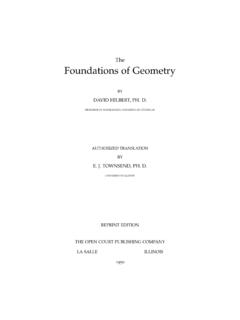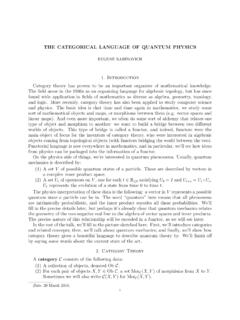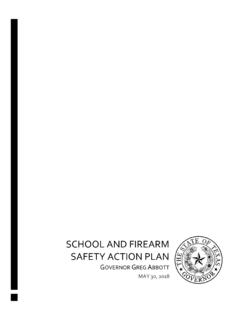Transcription of Textbook School Mathematicsand the preparation of ...
1 Textbook School Mathematics and the preparation of mathematics teachers . Stony Brook, October 27, 2014. H. Wu Aslightly expanded version of the talk on October 27, 2014. I am enor- mously indebted to Larry Francis for his many suggested improvements. School mathematics education has been national news for at least two decades. There have been constant reminders about our students' un- derachievement in TIMMS, PISA, and NAEP. There have been controversies over the Math Wars. There have been two edi- tions within five years of the report commissioned by Congress on the looming crisis in science and technology, Rising Above the Gathering Storm. And in the past two years, the pros and cons of the Common Core Standards have flooded the internet. Through it all, one conclusion is inescapable: School mathemat- ics education is in crisis. One can approach this crisis from many angles. Looking into either the administrative incompetence in the education estab- lishment or the faux pas in assessment would take up a whole day all by itself.
2 But for people in academia, I think the two most pressing concerns would have to be: School textbooks are no good. Teaching in the School classroom is no good. Mathematicians like to attack problems head-on. To us, the solution is simple: Write better School textbooks. Design better teacher preparation . I can tell you long stories behind these simple statements, but for now I will concentrate on teacher preparation and leave text- books to the end. Moreover, while pedagogy is important, the bigger issue by far is teachers' content knowledge deficit. The rest of this talk will be essentially about the content knowledge deficit. The kind of content knowledge math teachers need should (A) closely parallel what is taught in the School classroom, and (B) be consistent with the fundamental principles of mathematics (FPM). These two requirements pull in opposite directions, and this is what makes math education nontrivial. Thispoint is stressed in The mis-education of mathematics teachers, and is consonant with the viewpoint of D.
3 K. Cohen & H. C. Hill, Learning policy: When state education reform works. Yale University Press, 2001. Fundamental Principles of Mathematics Every concept has a definition. Every statement is precise about what is true and what is not true. Every statement is supported by reasoning. Mathematics is coherent: the concepts and skills are logically intertwined to form a whole tapestry. Mathematics is purposeful: there is a purpose to each skill and concept. The presence of the FPM in no way implies that we teach teachers only in the definition-theorem-proof format of university mathematics! (Remember (A) above.). Definitions can be handled in a grade-appropriate manner with- out sacrificing the FPM. For example, the definition of a fraction can be informal in grades 3 and 4 and, while a formal definition can be introduced in grade 5, it will not be an equivalence class of ordered pairs of integers (see, , Section of this book). Reasoning should also be grade-appropriate.
4 For example, the three-line proof of negative negative = positive in abstract algebra can be expanded for the consumption of middle School students ( , pp. 405 410 of this book). The location of the max and min of a quadratic function can be done by an elemen- tary method (see Section 11 of this article) without the use of the derivative. Another example: the proof of the laws of exponents using log x and exp x in calculus can be customized for use in high School (see Section 10 of this article). And so on. The overriding theme throughout this talk will be the need to provide teachers with content knowledge that informs and par- allels School mathematics. Teachers must try to teach School mathematics by following the FPM as much as possible because doing so makes mathematics more teachable and more learnable. For example, if teachers can give a reason for a skill, there would be no need to browbeat students into memorizing procedures. Or, by explaining to students the purpose of the concept or skill they are going to learn, teachers can get more buy-in from them and thereby improve their learning outcomes.
5 Take the laws of exponents for rational exponents: m k m+k an a` = an `. m k m k (a n ) ` = an `. m m m an bn = (ab) n Students are usually taught these laws as mindless procedures for simplifying expressions on standardized tests. This is understandable because the definition of rational expo- nents such as 3 4/5 is usually presented to them as just a differ- 1. ent notation for . 5 4. 3.. Therefore, 31/2 is just a fancy way to rewrite 3, and 31/5 is . 5. just a fancy way to rewrite 3. Nothing more. Why spend all that effort just to learn a new notation? In the next slide, you will see a Textbook introduce fractional exponents by throwing the formula p = 50f at students for . no apparent reason. Why not just write p = 50 5 f instead? Suppose we tell students, instead, that there is an interpolation (a way to connect the dots , see the next two slides) of the function n 7 3n defined on all positive integers n to a function x 7 3x defined for all real numbers x so that it satisfies the laws of exponents, , 3u 3v = 3u+v and (3u)v = 3uv , etc.
6 , for all real numbers u and v. We also tell them that these functions x 7 3x are the ones that describe natural phenomena related to growth and decay.. o 250. 200. 150. 100. o . 50. o .. o o . -1 0 1 2 3 4 5. Graph of n 7 3n o . 250. 200. 150. 100. o . 50. o . o . o . -1 0 1 2 3 4 5. Graph of x 7 3x Then on the basis of 3u 3v = 3u+v and (3u)v = 3uv for all real numbers u and v, we prove that 1. 3 4/5 = . 5 4. 3. and, in general, for positive integers m and n, we prove that 1. 3 m/n = . n m 3. This explains why the definitions of rational exponents are what they are and why we need them in mathematics. In particular, the laws of exponents describe some remarkable properties of the exponential functions x 7 ax. The purpose of studying the laws of exponents is therefore to get to know the basic properties of a special class of functions that show up each time we look at a natural phenomenon related to growth and decay. In particular, the laws of exponents describe some remarkable properties of the exponential functions x 7 ax.
7 The purpose of studying the laws of exponents is therefore to get to know the basic properties of a special class of functions that show up each time we look at a natural phenomenon related to growth and decay. If students see the laws of exponents from this perspective, they just might learn more and better. At the moment these fundamental principles of mathematics play almost no role in School classrooms. Teachers' teaching and students' learning are based on Textbook School Mathematics (TSM), the mathematics in School text- books for at least the past 40 years. TSM contradicts almost everything in the FPM. Here are the salient characteristics of TSM. 1. Definitions are absent or mangled. For example: number fraction the concept of less than the concept of equal . product of fractions quotient of fractions decimal negative number percent rate, constant rate length, area, volume slope variable expression congruence similarity graph of an equation graph of an inequality exponential function logarithm Comments: Anyone not familiar with K 12 will not believe that these funda- mental concepts could be left undefined, or less than completely defined, in TSM.
8 Here are some TSM definitions : a fraction is part of a whole . or a piece of pizza , but not a number; percent is out of a hundred ; a variable is a quantity that changes or varies ;. congruent is same size and same shape ; similar is same shape but not necessarily the same size , and so on. Number? negative number? rate? constant rate? length of a curve? area of a region? volume of a solid? Use your imagination. 2. No precision. TSM blurs the line between reasoning and heuristics: often it is not clear whether a statement is an assumption, a theorem, or a definition. For example, consider the following claims: A fraction is a ratio. A fraction ab is the division a b. a0 = 1 for all positive a. a m = a1m for all positive a and all integers m. The graph of a quadratic function is a parabola. Two nonvertical lines are parallel (or coincide) if they have the same slope, and are perpendicular if the product of their slopes is 1. The graph of an inequality ax + by < c is a half-plane.
9 Rational expressions can be added, subtracted, multi- plied, and divided like fractions. The graph of a quadratic function is a parabola. Two nonvertical lines are parallel (or coincide) if they have the same slope, and are perpendicular if the product of their slopes is 1. The graph of an inequality ax + by < c is a half-plane. Rational expressions can be added, subtracted, multi- plied, and divided like fractions. Many teachers, including a good many in high School , do not know the difference between a definition and a theorem. Comments: A reasonable explanation of any of these statements would re- quire more time than is at my disposal, but the following two pages from an Algebra I Textbook on parallel and perpendicular lines will serve to give a glimpse into this aspect of TSM. Notice that on the first page, the theorem that nonvertical lines are parallel if they have the same slope and different y-intercepts . is given as a Key Concept. Naturally, no proof is given.
10 The same comment applies to the situation with perpendicular lines on the second page. 3. Grade-appropriate reasoning is absent or flawed. This is the inevitable consequence of having no definitions or flawed definitions. Why division of fractions is equal to invert-and-multiply. Why a fraction can be converted to a decimal by the long division of the numerator by the denominator. Why ( a)( b) = ab. Why a b = a = a. b b Why we can solve an equation by manipulating symbols. Why the graph of ax + by = c is a line. Why simultaneous linear equations can be solved by tak- ing the coordinates of the point of intersection of the graphs. Why the minimum of f (x) = ax2 + bx + c lies on the b . line x = 2a Why c is a root of a polynomial p(x) if p(c) = 0. Why sin x = cos(x 90) and cos x = sin(x 90) for all real numbers x.. Why the area of a triangle is 1. 2 base times height: .. Comments: The lack of any proof for ( a)( b) = ab is too well-known for comments.















